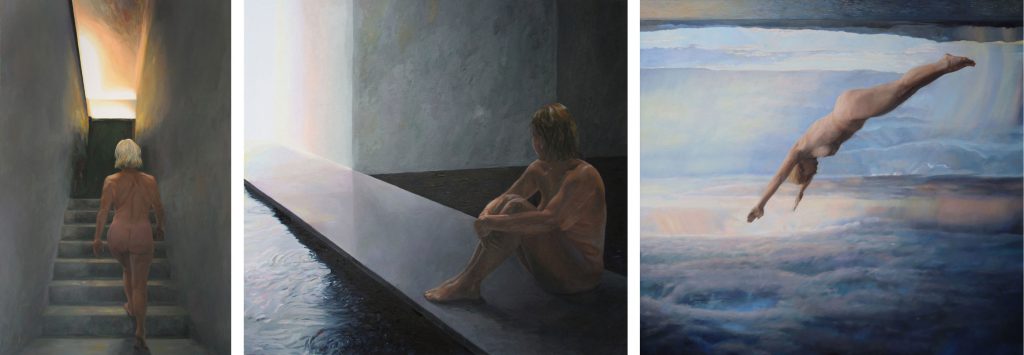
With the Eyes of a Painter
Maria Rosina Lamp dedicates her works to the human being with its many facets. In her portraits and nudes, the artist tries to capture the essence of a person and how they present themselves in the world and in the light. Who are you? - is a question the painter asks herself again and again. In doing so, she encounters a problem that is actually only known to quantum physicists: the more clearly one wants to determine a particle, the more blurred it becomes and, in the end, it threatens to disappear altogether.
This can also be applied to painting: here, two opposing characteristics of a motif cannot be perceived at the same time. It is necessary to simultaneously capture the person with his or her characteristics and personal expression, but also to perceive him or her as an object consisting of abutting, overlapping and interacting colour surfaces.
Dieses Dilemma zwingt Maler zu einer Art mäanderndem Blick, der zwischen den verschiedenen Eigenschaften und Sichtweisen hin und her springt, um ein harmonisches Ganzes zu erfassen. Es ist eine Arbeit, die eigentlich zum Scheitern verurteilt ist. Und doch gelingt es Maria Rosina Lamp Werke zu erschaffen, die von einer Lebendigkeit geprägt sind, wie es nur wenigen zeitgenössischen Malern gelingt – ohne in expressionistische Abstraktion oder fotorealistische Oberflächlichkeit zu verfallen.
This Side of Eden
The trilogy This Side of Eden (2015-2019) is a very personal work by Maria Rosina Lamp – not only thematically, but also motivically. In this study, she explores her own position in relation to the world - stretched between life and death. The three works are self-portraits showing a mature woman on her way from the here and now to an unknown beyond.
In a bare room, the painter climbs a staircase, at the end of which waits a jet-black passage that does not reveal what lies beyond. The scenery is reminiscent of Fritz Lang's silent film Der müde Tod (1921). In it, a nameless young woman tries to win back her deceased lover from death in a kind of inverted interpretation of the Orpheus myth. She is guided by Solomon's saying "Love is as strong as death".
In Lang's film, the world of the living and the dead are separated by a high wall. A seemingly endless staircase leads to the only entrance, at the end of which, however, the candlelit interior of a Gothic cathedral opens up. Maria Rosina Lamp refers to this element in her painting with the warm light shining in orange tones above the door. If one knows the artist's biography, then one knows that the early and unexpected death of her husband hit her very hard. In this respect, the first painting of the cycle is not only an examination of the question of where a person goes when life comes to an end. It is also indebted to the desire to have just one more chance to fight for her beloved, however hopeless this may seem.
In this respect, it is not surprising that the second picture in the series shows the artist sitting on a footbridge. She has the brightly shining light at the end in view, but does not allow herself to be seduced by it. She pauses, waits and abstains from making a decision.
This is achieved in the third and last picture Wolkensprung in an almost dynamic way. However, this jump only succeeds when the physical laws of this world are suspended and above and below are reversed. Thus it seems as if the artist is jumping downwards, but on closer inspection one realises that she is jumping into the cloudy sky. It remains unclear what awaits her at the end, but the third image in particular conveys a dynamic confidence and almost playful curiosity. (Vivien Rathjen M.A.)